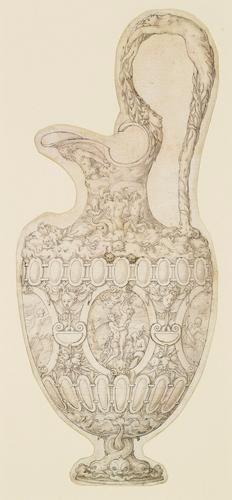A design for a ewer with the story of Apollo and Daphne c.1560-80
Pen and black ink with brown wash on vellum, cut around outline of drawing | 24.7 x 10.5 cm (sheet of paper) | RCIN 913053
-
A pen and ink design for a ewer.
Etienne Delaune was the son of Lèonard Delaune, a royal tailor. He worked in Paris for much of his career, encountering trouble in 1545 for undertaking goldsmith’s work without a licence. Delaune appears to have taken up printmaking in 1561, issuing a number of engravings over the next 20 years. In 1573, a year after the St Bartholomew’s Day Massacre, he moved to Strasbourg, a city more in line with his Calvinist beliefs. For the last few years of his life he appears to have travelled between Strasbourg and Paris, dying in the latter city in 1583.
Etienne is best known as a designer of goldsmith’s work - coins, medals and armour - drawings for which survive in a number of collections, particularly the Louvre in Paris and the Ashmolean Museum in Oxford. Many of his designs for jewellery and coins are on a tiny scale, and it is probably for this reason that he tended to work on vellum, which has a smoother surface than paper and is more suited to very detailed drawing. Some of Delaune’s works, like the present example, have been trimmed to the shape of the design. A number of his drawings, including this one, were probably made as presentation pieces for patrons, to facilitate approval of a design before an object was made.
The ewer is a fine example of Delaune’s meticulous draughtsmanship and inventive imagination. The central medallions show the story of the nymph Daphne, who was pursued by an amorous Apollo and was changed into a laurel tree to escape his advances. In the centre can be seen the moment of transformation, as Daphne twists upwards, out of Apollo’s grasp. This motif is cleverly repeated in the handle, which is formed as a woman with limbs of laurel. Daphne’s story is particularly appropriate for the decoration of a ewer, made for the holding and pouring of liquid, as she effected her escape with the help of the river god Peneus, who can be seen sitting to the right of the central scene, bent over his urn of water. This theme is continued in the register above, which shows tritons amid waves, and in the foot, which is composed of elegantly entwined dolphins.
Catalogue entry adapted from The Northern Renaissance. Dürer to Holbein, London 2011Provenance
In the Royal Collection by c.1926
-
Creator(s)
-
Medium and techniques
Pen and black ink with brown wash on vellum, cut around outline of drawing
Measurements
24.7 x 10.5 cm (sheet of paper)
Object type(s)
Other number(s)
RL 13053












